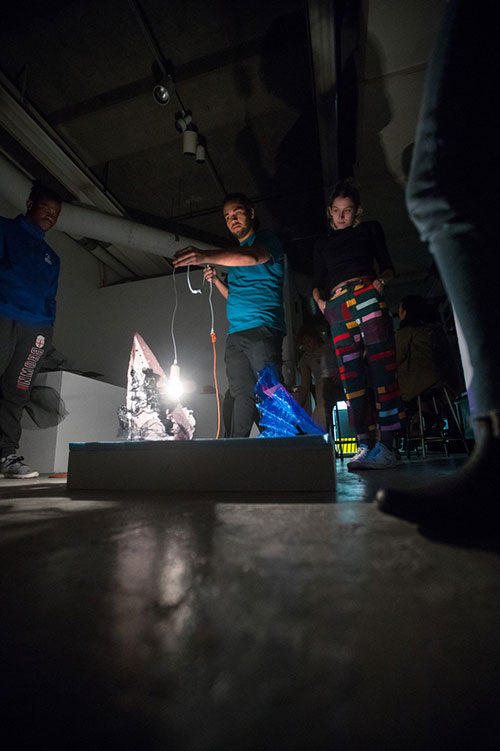PROVIDENCE, R.I. [Brown University] — Brown University junior Melody Hsu knew that a computer science (CS) course would be a good way to inject a little more “applied” into her applied math concentration. But she’d never taken a CS class before and wanted to jump in without the competing demands and distractions that any traditional semester was sure to bring.
Brown’s Wintersession — a mini-term sandwiched between the fall and spring semesters and designed to give students a unique compressed learning experience — offered her just the chance. She opted for “Deep Learning in Brains, Minds and Machines,” taught by associate professor Thomas Serre.
“It was a great opportunity to throw myself into one thing and not have to worry about keeping up with other classes and other commitments,” Hsu said.
The four-week course explored deep learning, the technique currently driving a revolution in artificial intelligence. Going beyond a standard computer science class, it combined the topics of machine learning, computer vision, cognitive psychology and neuroscience.
“For me, it was a really good way to build my computer science foundation and explore some really cutting-edge topics in AI,” Hsu added.
Hsu is one of more than 165 students taking courses at Brown in January via Wintersession, now in its second year. Students can take one class only, for which they earn credit equivalent to a regular semester-long course. This year, six classes were taught on campus; three destination courses included travel to Taiwan, Israel and Barbados; and two online courses had students participating remotely. Courses spanned the disciplines, ranging from sculpture to public health to English literature.
An opportunity for immersive, focused learning
In Associate Professor of Visual Art Paul Myoda’s course “Illuminated Sculpture,” students from a range of disciplines spent three weeks exploring light as a material in the context of contemporary sculptural practice.
Students created three projects: a lantern, an illuminated space and a final work of art using light. Between Jan. 2 and 19 — with a snow day included — students learned to work with hand tools, power tools and machine tools, created designs with Adobe Illustrator, configured electrical circuits, studied color theory and analyzed what makes a sculpture persuasive.

To accomplish all of that and more, students spent about 20 hours in class each week, as well as significant time in the studio outside of class.
Sophomore Leslie Benavides, a public policy concentrator for whom “Illuminated Sculpture” was her first visual art class at Brown, said that the intensive format led to prodigious advances; she was surprised at how much growth she could see in her projects from one week to the next. She and her classmates came to know each other very quickly, she said, as they got to know what she called “our 4 a.m. selves” and “our 3 p.m. selves.”
Myoda said he appreciated the effect the immersive format of the Wintersession course had on his students.
“While it was challenging taking a semester-long course and condensing it into three weeks,” Myoda said, “an esprit de corps developed among the students very quickly. I think the students appreciated it because they usually juggle four or five classes. You could tell they were excited about the kind of focus the course allowed.”
For Andrew Brodsky, a junior concentrating in mechanical engineering whose final project is a suspended metal globe with hundreds of tiny holes drilled into it, that focused time was useful as he completed his labor-intensive piece, and something he had struggled to find when he took previous visual arts classes.
Adapting instruction, fueling new discoveries
Wintersession also offers professors a chance to experiment with courses they have taught before, as they adapt their teaching to different settings and timeframes. Professor James Egan first taught his online Wintersession offering, “Fantastic Places, Unhuman Humans,” as a full-semester, though still online, course and then adapted it to the shortened Wintersession length.
The course explores how monstrous and alien creatures — like Frankenstein, zombies and androids — in a range of literature across many centuries reveal the different ways people have imagined what it means to be human.
Since the course was a literature-focused one that involved reading and analyzing several novels, the main adjustment Egan had to make for Wintersession was to rethink the readings for a tightened timeframe. Rather than exploring all the novels from the full-semester course, Egan designed a series of shorter readings that students had to respond to each day.
“The experience became more intense and concentrated,” he said. “I do think that the shorter stories in place of the novels allowed them to get a fuller grasp of a wider variety of literary works on the topic. And that helped get them to think about the topic in a more complicated and valuable ways.”
“Fantastic Places, Unhuman Humans” will go through another iteration starting Jan. 30 when Egan will offer the course through BrownX, which offers a variety of online courses to the general public at no cost.
Egan says that the changing contexts — from online course to Wintersession class to massive open online course (or MOOC) — and audiences have led him to new thinking about ways to teach material with which he is also deeply engaged in his own scholarship.
“Putting this course together has been such an engaging pedagogical experience,” Egan said. “And it’s a great opportunity for students because they get to take an unusual course that they might not have taken otherwise.”